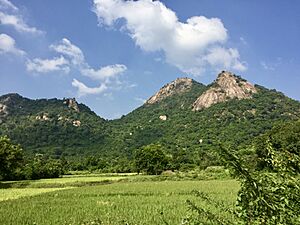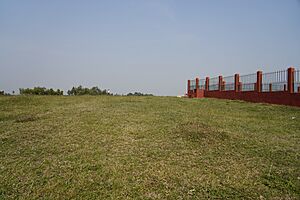History of West Bengal facts for kids
The history of West Bengal is about the western part of Bengal. This region is in the eastern part of the Indian subcontinent. People have lived in West Bengal for a very long time. We have found proof of human settlements from about 42,000 years ago. These old settlements were found in the Ajodhya Hills of West Bengal.
Around 2,000 BCE, people started living in settled communities. This happened in the Damodar-Ajay River Valley. This was at the same time as the Harappa-Mahenjodaro civilization. Later, the southern part of West Bengal was home to the Vanga Kingdom. This kingdom existed between 1100 BCE and 350 BCE. It was around the same time as the Vedic civilization in North India.
Around 350 BCE, the Magadha kingdom became very strong. The rulers of the Nanda dynasty from Magadha took control of West Bengal. After the Nanda Empire, West Bengal was part of all the big empires centered in Magadha. Tamralipta in West Bengal was an important seaport for the Maurya Empire. Most of West Bengal was also ruled by the Gupta Empire. This empire grew in northern India after the Magadha empires ended.
In 690 AD, the Gaur kingdom was formed in Bengal. It covered parts of West Bengal and modern-day Bangladesh. Gaur is seen as the first truly independent kingdom in Bengal. After Gaur, the Pala Empire started in 750 AD. Then the Sena Empire began in 1070 AD. Both of these empires were mainly based in Bengal.
Islamic rule came to West Bengal in the 13th century. Bengal, including West Bengal, became part of the Ghaznavid Empire. West Bengal was ruled by the Delhi Sultanate from the 13th to the 14th century. Then it was part of the Bengal Sultanate from the 14th to the 16th century. After the Bengal Sultanate fell, West Bengal joined the Mughal Empire.
Murshidabad in West Bengal was the capital of independent Nawab Bengal (1717–1765). In 1765, the British took control of Bengal from the Nawabs. In August 1947, the Bengal Presidency was divided. West Bengal became part of Dominion of India and became an Indian state.
Contents
Ancient Times (until about 2000 BCE)
The Stone Age
The Stone Age in West Bengal covers the time from when humans first lived there. This includes the Old Stone Age, also called the Palaeolithic era. Most Palaeolithic sites are found in river valleys. These include the upper Gandeshwari, middle Dwarakeswar, and upper Kangsabati valleys. The forests and moderate rain in southwestern West Bengal were perfect for early humans.
Proof of human life from 42,000 years ago has been found in West Bengal. These settlements were discovered at Kana and Mahadebbera. They are at the foot of the Ajodhya Hills. Small stone tools, called microliths, from Kana are 42,000 years old. Those from Mahadebera are 34,000 to 25,000 years old.
At Hatpara, near the Bhagirathi River, there is proof of settlements from 15,000-20,000 years ago. About 200 small stone weapons were found there. Grains and fish bones were also discovered. Experts believe the Hatpara civilization spread along the Bhagirathi River. Fish was a common food. The burnt fish bones show they cooked their food.
During the Middle Stone Age, or Mesolithic period, sites were found in two main areas. These were the western plateau and the delta region. The stone tools from this time were mostly simple. They included blades, points, and scrapers. Not many things from this period have been found.
The New Stone Age, or Neolithic culture, grew in five main river valleys. These include the Ajay-Mayurakshi and Dwarakeswar-Damodar valleys. A Neolithic culture also developed in Kalimpong. Tools found from this time include axes, chisels, and perforated tools.
Copper Age (about 1500 – 600 BCE)
The Copper Age, or Chalcolithic period, began around 1500 BCE. This is when copper objects first appeared. The Copper Age culture in West Bengal happened at the same time as the Later Harappan and Vedic civilizations.
A Copper Age culture thrived in the Ajay-Damodar valley. This culture lasted from about 1500 to 600 BCE. It included towns like Pandu Rajar Dhibi, Mangalkot, and Bharatpur. These are in modern-day Burdwan division. Dihar is in modern-day Medinipur division. At Pandu Rajar Dhibi, spiral bangles, rings, and fish-hooks made of copper were found.
In West Bengal, a type of pottery called Black and red ware (BRW) was common. This pottery was used during the Copper Age and early Iron Age. It was found in the central and eastern Ganges plain. It was used until about 700–500 BCE. After that, the Northern Black Polished Ware culture took over.
Iron Age (about 1000 – 28 BCE)
The Iron Age brought many changes. People started using metal weapons and coins. Farming and irrigation methods also improved. Many places in West Bengal changed from the Copper Age to the Iron Age. Iron Age sites have been found in the western and southwestern parts of West Bengal. The main Iron Age culture here was the Northern Black Polished Ware.
Areas like Birbhum, Medinipur, Purulia, and Bankura were major producers of iron. The ancient Indian epic Mahabharata mentions the Vanga Kingdom. The western part of Vanga was in West Bengal. Vanga was known for its sea power. It had colonies in Southeast Asia. According to Sri Lankan history, the first king of Sri Lanka, Prince Vijaya, came from West Bengal. He led a fleet from India to conquer the island.
Ancient Regions of West Bengal
Ancient Bengal had several important regions. Some of these were located in what is now West Bengal. These regions grew and shrank over time. The main ones in West Bengal were Pundravardhana, Vanga, Suhma, and Radha.
The western part of Pundravardhan is now part of the Malda division. The western part of Vanga is in the modern-day Presidency division and Medinipur division. All of Suhma was in the modern-day Burdwan, Medinipur, and Presidency divisions. Radha was also likely in modern-day West Bengal.
West Bengal under Big Empires
During the Iron Age, West Bengal was part of empires centered in Magadha. Greek writings mention the Gangaridai people of Bengal. They lived in modern-day West Bengal and Bangladesh. These writings suggest that both areas were ruled by the same kings.
Historian Hem Chandra Raychaudhuri believes the Nanda rulers had strong control over their main lands. These were in present-day Bihar and Uttar Pradesh. But they allowed other parts of their empire, like West Bengal, to have some freedom.
Bangarh, located about 400 km from Kolkata, shows early history of West Bengal. It has artifacts from the Maurya period to the Pala period. Iron Age items from the Pre-Maurya, Maurya, and Sunga periods have been found here.
West Bengal was important for sea trade for the Magadha empires. They traded with other countries through the Tamralipta seaport. This port was near the modern-day Tamluk city. When the Maurya Empire grew, Tamralipta became the main port for the entire region. Ships from Ceylon, Southeast Asia, West India, and the Middle East came to this port. Chandraketugarh was another port city. It was on the banks of the Bidyadhari River. Artifacts like terracotta statues and chariots from the Mauryan and Sunga periods have been found there.
Modern Era
British East India Company (1772–1858)
The British East India Company became very powerful in West Bengal. In the mid-1750s, the Company started making Fort William (in Calcutta) stronger. Nawab Siraj ud-Daulah attacked with support from the French.
Under Robert Clive, British troops defeated the Nawab. They captured Chandannagar in March 1757. Then, they won a big victory at the Battle of Plassey on June 23, 1757. The British then chose who would be the Nawab of Bengal. They slowly took more direct control. The French got control of Chandannagar back in 1763.
In 1765, Mir Qasim and Shuja-ud-Daula teamed up with the Mughal emperor Shah Alam II. They tried to take Bengal back. But they were defeated again at the Battle of Buxar (1765). As part of a deal, the East India Company got the right to collect taxes from Bengal. So, the Company became the tax collector. The local Nawabs still ruled the province. This system ended in 1772. The East India Company then took full control.
As the Mughal Empire weakened, Calcutta in West Bengal became a major center for Indian culture and trade. The East India Company used money from Bengal to invest in industries in Great Britain. This included textile manufacturing. The Company's policies led to the decline of Bengal's textile industry. This is called de-industrialization. Murshidabad, a big textile center in West Bengal, became poor. Robert Clive had once said Murshidabad was richer than London.
During the Company's rule, a terrible famine happened in 1770. About 7 to 10 million people died. This event is known as the Chiẏāttôrer mônnôntôr. West Bengal and Bihar were hit the hardest. Central and North Bengal, now parts of the Malda and Jalpaiguri divisions, suffered greatly. The famine ruined the region's economy.
India's second railway line was built in West Bengal. It connected Howrah and Hooghly. In 1854, train service started between Howrah and Hooghly. The first university in India and Bengal under British rule was also set up in West Bengal in 1857. It is known as the University of Calcutta.
See also
- History of West Bengal (1947–present)
- History of Bengal






